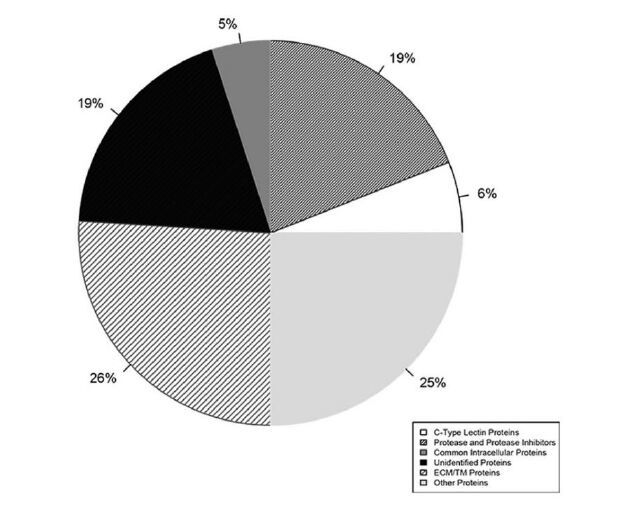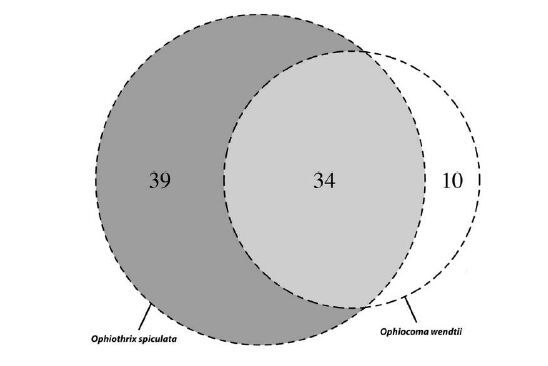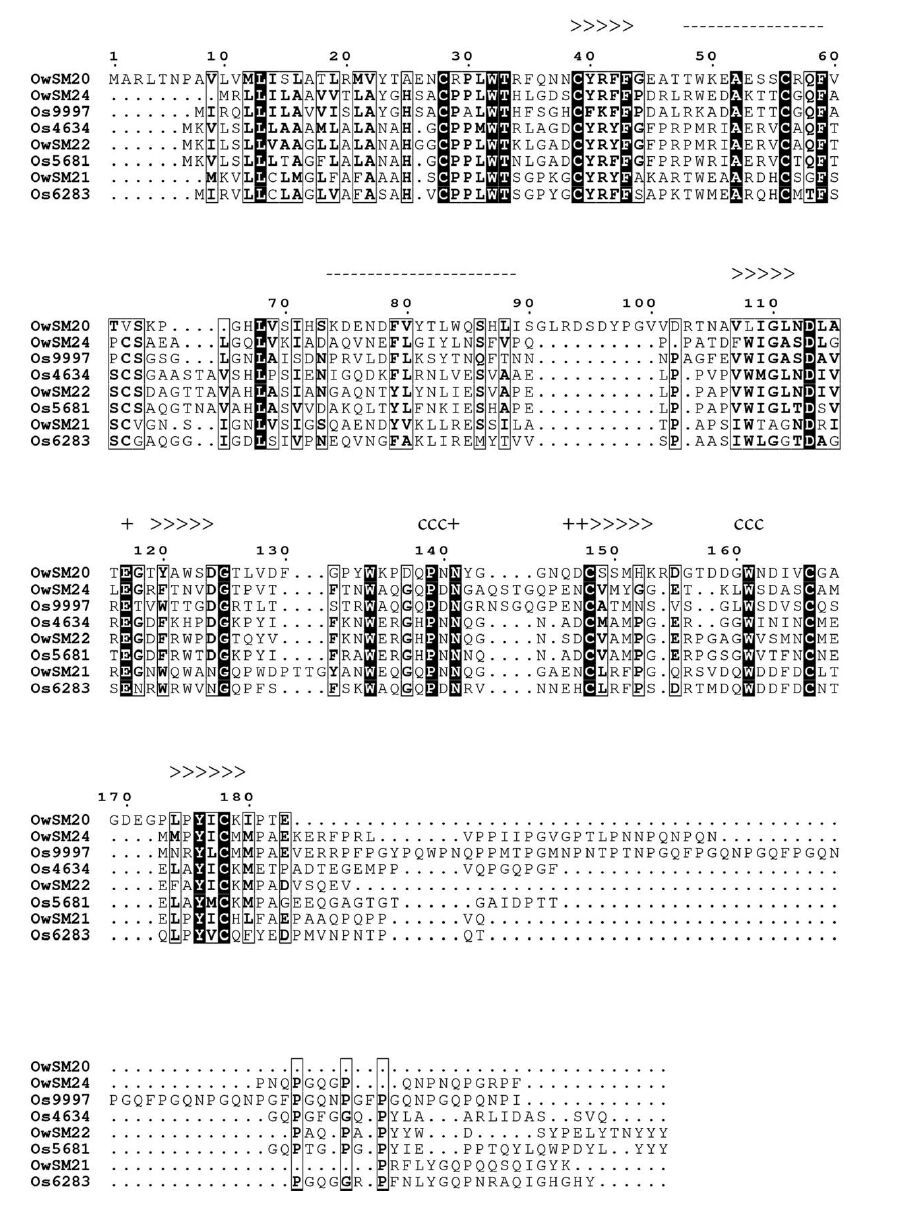1. Introduction
Biomineralization is found in multiple animal groups and involves the interaction between cells and secreted extracellular matrix components [1,2,3]. Calcium is transported through cells in vesicles and deposited on the extracellular material, where it forms the crystalized mineral. This process has been extensively studied, and a large number of secreted proteins have been identified, but the functional role of these proteins and how they are organized to form mineralized structures in a controlled pattern has remained elusive. Echinoderms have been used as a simple model system to study the process of biomineralization. The proteins found in the sea urchin skeleton have been most extensively studied. Using the genome of the sea urchin Strongylocentrotus purpuratus [4], proteomic studies have identified over four hundred proteins found occluded within the sea urchin skeleton [5,6,7,8]. The most abundant of these proteins are unusual C-type lectins called spicule matrix proteins. These are secreted proteins that are acidic, contain a C-type lectin domain as well as a repetitive domain with varying numbers of a six to eight amino acid repeats [9]. The exact sequence of the amino acids in the repeat vary, but all are similar in nature. Of the spicule matrix proteins examined, all are found in the organic matrix onto which calcium is precipitated.
In a recent study we examined the conservation of these spicule matrix proteins in a related group of echinoderms, the brittle stars, or Ophiuroids, using the Caribbean brittle star Ophiocoma wendtii [10].Isolation of skeletal proteins followed by proteomic analysis revealed 44 proteins. Of these, four were C-type lectins. These proteins were secreted, had similar amino acid content and had a similar overall charge as the sea urchin spicule matrix proteins, but lacked the repetitive domains. An analysis of the relationship between the sea urchin and brittle star C-type lectin proteins indicated they likely arose independent of one another, but the confidence levels of the analysis were weak. Having only a single representative of the ophiuroids to compare to sea urchins makes it difficult to determine how conserved the C-type lectins are in this group, which is something we address in this study. We also identified a diversity of other proteins in the brittle star skeleton, some of which are also present in the sea urchin, but the importance of these proteins was not clear. Many of these proteins had not previously been implicated in skeleton formation in echinoderms. We wished to examine another brittle star to ensure the presence of these proteins was not an artifact of our analysis.
Here we examine the skeletal proteome of a brittle star from the Pacific coast, Ophiothrix spiculata. We detect 77 proteins occluded with the skeleton, most of which were homologous to the proteins found in the Caribbean brittle star, including C-type lectins. We compare these proteins to those in both Ophiocoma wendtii and the sea urchin Strongylocentrotus purpuratus. The results indicate that the proteins we have identified are highly conserved, and suggests that C-type lectins play a role in skeleton formation. However, they indicate that the extensive gene duplication and highly repetitive regions of the sea urchin spicule matrix proteins are not required for biomineralization.
2. Materials and methods
2.1. Skeletal preparation
Isolation of clean skeletal elements was as described in Seaver and Livingston [10]. Arms of 2-8 adult brittle stars were rinsed with deionized water (DI) water then stirred vigorously in cold sodium hypochlorite (5% active chlorine, Acros Organics). The resulting skeletal elements were washed 5X in cold, DI water, then ground with a mortar and pestle. Ground mineral was homogenized with homogenization buffer (4.5 M Guanidine Isothiocyanate, 0.05 M Sodium Citrate, 5% (v/v) b-mercaptoethanol, 0.5% (w/v) Sarkosyl) in a 40 mL homogenizer. Ground, homogenized skeletal elements were transferred to sterile 50 mL conical tubes and washed 5X in cold, sterile DI water. This treatment resulted in finely ground mineral, free of attached organic material.
2.2. Purification of skeletal proteins
Purified skeletal elements were de-mineralized in cold acetic acid (~40 mL 25% (v/v)/g mineral) under gentle agitation until mineral was dissolved. The supernatant was transferred to Spectra/Por 6 Dialysis Membrane MWCO 6-8000 (Spectrum Laboratories, Greensboro, NC) for dialysis. Dialysis was against 1% acetic acid, DI water, then 0.001 M and 0.0001 M TRIS base solutions. Dialysis solution was changed after 12 hours. After dialysis, a small amount of precipitate remained, but was removed before further processing. The soluble fraction was concentrated using Amicon Ultra-15 centrifugal filter units, followed by Amicon Ultra-0.5 centrifugal filter units (3000 NMWL) (Millipore, Bellerica, MA). Samples were dissolved in NuPAGE LDS sample buffer under reducing conditions (Invitrogen, Carlsbad, CA) and the proteins separated by SDS-PAGE using NuPAGE 4-12% Bis-Tris Polyacrylamide gels 1.0 mm, 10-well in the MES buffer system (Invitrogen, Carlsbad, CA). Running times, protocols, and reagents were used as described by the manufacturer (Invitrogen, Carlsbad, CA). Gels were incubated on an orbital shaker in gel fix (45% (v/v) methanol, 10% (v/v) acetic acid) for one hour, followed by 3X ten minute washes in DI water. Gels were stained with SYPRO RUBY Protein Gel Stain.
2.3. Sample preparation
Protein quantitation was performed by Qubit Fluorometry (Invitrogen, Carlsbad, CA). A total of 20 µg of material was separated on a 4-12% Bis Tris NuPage gel (Invitrogen, Carlsbad, CA) in the MOPS buffer system. The gel lane was excised into twenty equally sized segments. Using a robot (ProGest, DigiLab), gel pieces were reduced with 8 mM dithiothreitol at 60 °C followed by alkylation with 10 mM iodoacetamide at RT. Samples were then digested with sequencing grade trypsin (Promega, Madison, WI) at 37 °C for 4 h and quenched with formic acid. The supernatant was analyzed directly without further processing.
2.4. Mass spectrometry
For each of the 20 fractioned gel slices, LC-MS/MS was performed identically. The digested sample was analyzed by nano LC/MS/MS with a Waters NanoAcquity HPLC system interfaced to a ThermoFisher LTQ Orbitrap Velos. Peptides were loaded on a trapping column and eluted over a 75 µm analytical column at 350 nL/min; both columns were packed with Jupiter Proteo resin (Phenomenex). The mass spectrometer was operated in data-dependent mode, with MS performed in the Orbitrap at 60,000 FWHM resolution and MS/MS performed in the LTQ. The 15 most abundant ions from each precursor scan from each gel slice were selected for MS/MS. There were several thousand precursor scans in each LC-MS/MS experiment.
2.5. Data processing
Data were searched using a local copy of Mascot against the NCBI non-redundant protein database as well as 454-sequenced brittle star tube foot transcriptome and genomic contigs. The Contigs and Singletons database was also translated in all six frames using Proteomatic 1.2.1 (University of Munster) to visualize reading frame. The translated database was appended with common contaminants, reversed and concatenated. Trypsin was input as the digestive enzyme, mass values were monoisotopic, the peptide mass tolerance was 10 ppm, the fragment mass tolerance was 0.8 Da, and the maximum number of missed cleavages was 2. Carbamidomethylation (C) was set as a fixed modification and variable modifications included oxidation (M), acetyl (N-term), pyro-glu (N-term Q), and deamidation (NQ). Mascot DAT files were parsed into the Scaffold software for validation, filtering and to create a non-redundant list per sample. The data were filtered using a minimum protein value of 95%, a minimum peptide value of 50% (Prophet scores) and requiring at least one unique peptide per protein.
3. Results and Discussion
Skeletal proteins from O. spiculata were isolated and resolved into a number of major bands on SDS-PAGE gels. The proteins are clearly intact and span a large range of molecular weight (Figure 1). This is critical since SDS-PAGE was used to fractionate the proteins for LC/MS/MS analysis. The O. spiculata gel lane was divided into 20 equal slices and each slice was processed independently. The proteins in the gel slices were digested with trypsin and analyzed by LC/MS/MS. The top 15 ions for every precursor scan from liquid chromatography of each gel slice were subjected to MS/MS. The data was compared to O. spiculata nucleotide sequence databases as described for O. wendtii [9]. A total of 3959 spectra identified ninety proteins. After removal of common contaminants and peptides that mapped to short open reading frames, 73 proteins were identified.
When placed into functional groups the distribution of identified proteins resembled that seen in the skeletal proteome of the brittle star Ophiocoma wendtii [9]. The largest classes of proteins with defined functions observed were extracellular matrix (ECM) and transmembrane proteins (26%), proteases and protease inhibitors (19%), C-type lectins (6%) (Figure 2). There were also a number of common intracellular proteins as well as proteins of unknown function.
Comparison of the proteins found in the two brittle stars by reciprocal blasts showed a high degree of conservation between the two species (Figure 3). Seventy-seven percent of the proteins that were identified in O. wendtii were homologous to proteins identified in O. spiculata. These two species have been separated for at least three million years, but clearly maintain considerable homology in the proteins used for skeleton formation. Table 1 shows the major proteins that are conserved between the two brittle star species. The proteins that matched the largest percentage of the observed spectra correspond to visible bands on the SDS-PAGE gel (Figure 1), although the sensitivity of the LC/MS/MS identifies proteins spread over a wider range of the gel than would be predicted by the Molecular Weight (MW). Fibrinogen C was found in slice 11, C-type lectins in slices 12 to 15. The C-type lectins ran slightly higher than their predicted MW, but these proteins are often glycosylated. The major band in this region appears composed of a C-type lectin, a novel protein, an agrin-like protein and a matrix metalloproteinase (MMP). The ldl-receptor is found in slice 4, Cub domain containing proteins in slices 5-6, Ig-domain containing proteins in slice 8, and the syndecan/SEA protein identified in O. wendtii in slice 10 [9]. The predominant proteins found in slices 16-17 were agrin/kazal proteinase inhibitors and a matrix metalloproteinase, which also appears higher in the gel and may represent a proteolytic fragment. Most of these proteins are also found in the S. purpuratus skeletal proteome, and some have been found in vertebrate bone. We discuss these further below.
Table 1.Major proteins in skeletal proteome
| Protein
|
Number in proteome
|
| Matrix Metalloproteinase
|
5
|
| Fibrinogen C
|
5
|
| Semaphorin
|
5
|
| C-type lectins
|
4
|
| Agrin-like
|
4
|
| Ig domains
|
3
|
| Actin
|
3
|
| Tolloid-like/Cub domain
|
2
|
| EGF_CA family
|
2
|
| Transferrin
|
2
|
| Collagen
|
2
|
| ras/rab family protein
|
2
|
| Carbonic anhydrase
|
1
|
| Syndecan/SEA protein
|
1
|
| Calmodulin
|
1
|
| Novel protease
|
1
|
| Ldl receptor-like
|
1
|
Secreted matrix metalloproteases have been found in all echinoderm skeletal proteomes. This suggests that proteolytic modification of extracellular material may play a role in skeleton formation. Similarly, there is also a novel secreted protease with similarity to neurotrypsin [10] found in both sea urchin and brittle star skeletons. Agrin-like proteins are also found in all of the echinoderm skeletons studied. Agrin interacts with neurotrypsin at the neuromuscular junction and is believed to have a signaling role [11]. Such an interaction could play a role in echinoderm skeleton formation as well.
Carbonic anhydrase was also found in all echinoderm skeletal proteomes, and has been shown to play a role in the formation of calcium carbonate skeletons in a number of invertebrates [12,13,14,15]. Recently it has been shown to be required for skeleton formation in sea urchins [16]. Calmodulin was also found, along with several other proteins with calcium binding sites. These include an Ldl receptor-like protein. Related proteins have been implicated in the formation of vertebrate bone [17]. Other proteins identified in the O. spiculata and O. wendtii skeletal proteomes that have also been found in the human bone [18] or matrix vesicle [19] proteomes include actin, collagen, agrin/scavenger receptor proteins, carbonic anhydrase, calmodulin and fibrinogen C. One protein that is unique to the brittle star skeletal proteome contains a C-terminal syndecan domain followed by a SEA domain, an agrin like domain. This combination of protein domains was previously observed in O. wendtii, but had not previously been described elsewhere. Detection of the homologous protein in O. spiculata verifies the protein is not a sequence artifact and suggests it plays a role in the brittle star skeleton.
A fibrinogen C or ficolin-like molecule was prominent in the brittle star skeletal proteome. This is a protein with a lectin domain that binds carbohydrate in a calcium dependent manner. This lectin protein is one of the most abundant in both brittle star skeletal proteomes, and is also present in the sea urchin skeleton [4,5,6], although it is not as abundant.
The most prevalent proteins in the sea urchin skeletal proteomes are C-type lectins called spicule matrix (SM) proteins [4,5,6]. These proteins are characterized by lectin domains as well as unusual repetitive regions [7]. The importance and evolution of these proteins is still unclear and needs to be elucidated. To further our knowledge of the role of such proteins, we have analyzed the brittle star C-type lectins in more detail. The O. spiculata skeletal proteome contained four C-type lectins. They are all in the mid-twenty kilodalton range in molecular weight (MW) as derived from their nucleotide sequence and all are acidic (Table 2). The phylogenetic relationships between the O. spiculata and O. wendtii skeletal C-type lectins is shown in Figure 4. Os SM22 and Ow SM22 seem to be direct homologues, as do O. spiculata SM23 and O. wendtii SM24. The exact relationship between the other lectins is unclear. Figure 5 shows an alignment of the C-type lectins from both O. spiculata and O. wendtii. The proteins have the typical double loop structure of C-type lectins [20,21]. There are five beta strands and two alpha-helices in each protein. The Beta 2 strand can be identified by the WIGL sequence in the O. spiculata 5681/SM22 and the O. wendtii SM22 proteins [21]. These proteins, along with O. spiciulata 46342/SM24 proteins have an additional beta-strand at the NH2 terminal of the protein. The O. spiculata 62832/SM 23 and 9997/SM 27 proteins have a potential alpha helix in the same position. All of the proteins have six conserved cysteines capable of forming disulfide bonds. The first two could potentially aid in stabilizing a hairpin at the N terminal of the proteins. This has been found in some C-type lectins [21]. The other four cysteines are in positions suggesting they play a conserved role in stabilizing the C-type lectin double loop structure [20]. There are also four conserved calcium binding sites. The second calcium binding site lies adjacent to sequences that have been implicated in binding carbohydrate. Either an EPN sequence, which binds mannose, or a QPD sequence, that binds galactose, lie adjacent to the second calcium binding site [21]. Downstream is another sequence involved in calcium binding, normally WND. Only the O. wendtii SM 20 protein contains the canonical carbohydrate binding sequences that indicate it would bind galactose. The other proteins have variations in the canonical sequences that have been implicated in binding to carbohydrates. It is not clear how these variations could affect carbohydrate binding. Interestingly, the variation in these sequences follows the evolution of these proteins, suggesting that changes in these sequences occurred before the divergence of the two species, and that the changes have been conserved. This suggest that the changes are functional.
Table 2.Ophiothrix spiculata C-type lectins
| Identifier
|
Domain architecture
|
MW
|
pI
|
Designation
|
| 5681
|
C-type lectin domain
|
22,584
|
4.77
|
Os SM22
|
| 9997
|
C-type lectin domain
|
27,822
|
4.81
|
Os SM27
|
| 62832
|
C-type lectin domain
|
23,240
|
5.15
|
Os SM23
|
| 46342
|
C-type lectin domain
|
23,853
|
4.69
|
Os SM24
|
Overall we have found a high degree of conservation of the proteins found in the skeleton of two brittle stars from opposite sides of North America. Many of these proteins are also found in sea urchins. This suggests that these proteins play a functional role in skeleton formation. Included in the proteins conserved between the two brittle stars are C-type lectins, which are the predominant proteins found in sea urchin skeletal proteomes. The brittle star C-type lectins contain protein domains characteristic of this class of protein, suggesting functional conservation of the ability to bind carbohydrates in a calcium dependent manner. There are fewer C-type lectins found in the brittle star skeleton, however, and they lack the repetitive domains characteristic of sea urchin spicule matrix proteins.
Acknowledgements
We would like to thank Andy Cameron (CalTech) and the Echinobase genomic database (http://www.echinobase.org/Echinobase/) for providing genomic resources. This work was supported by a grant from the California State University CSUPERB organization. RLF was supported by NIH T34 GM008074. This work was conducted all or in part by data generated and shared from NSF award #1036416 Collaborative Research: Assembling the Echinoderm Tree of Life.
Conflict of interest
None declared.










 DownLoad:
DownLoad: 













